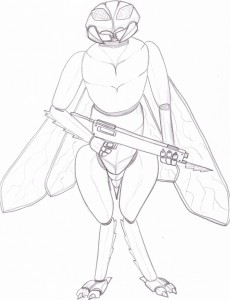The Mantid
 Highly adaptive, fast-evolving, scavenging insectiods, the Mantid are an alien species spread through the Skein Reach. Terrans describe them as looking like a cross between a praying mantis, a wasp, or a humanoid ant.
Highly adaptive, fast-evolving, scavenging insectiods, the Mantid are an alien species spread through the Skein Reach. Terrans describe them as looking like a cross between a praying mantis, a wasp, or a humanoid ant.
Individuals and colonies vary considerably as the Mantid’s genomes will adapt newly laid members to their environment within a few generations. Thus it is common so see a population of Mantid that are adapted to a tiny abandoned space station, or a world with an otherwise toxic atmosphere. Their carapace can be of any color based on available minerals and their place in Mantid society. For example, warriors will often have dark stripes or patterns contrasting with grays or earth tones. The statistics presented below represent typical examples of those who are adapted to living on starships or space habitats.
The Mantid are extremely social creatures and demonstrate high degrees of cooperation and devotion to their colony. Though their language is not well understood, xenobiologists postulate that they communicate both with a spoken symbolic language and through pheromones. These chemical communications seem to generate simultaneous emotional responses through a colony – if one is attacked the fight-or-flight response rapidly spreads to all Mantids in a group. Most other sentient creatures find the Mantid’s pheromones unpleasant and describe their habitats as “smelly” or “stinky”.
Their spoken language mainly consists of patterns of clicks with varying frequency, volume, and tone, and is very difficult for non-insectiod sophants to reproduce. They cannot make the sounds of galactic standard, and therefore cannot communicate with most travellers without translators. In addition, due to the fact that most Mantid emotional content is communicated by smells, even those using translator droids or portable translators find them difficult to understand. When spoken to they come across as overly literal and disjointed.
The result of these communication barriers is that in most encounters with Mantid vessel neither party tries to communicate at all. In the Skein Reach it’s conventional wisdom that when you spot a Mantid ship they’re either going to attack you for scrap or ignore you, based on weather they think they outgun you.
Their vessels generally use an asteroid for the hull, though they will also build ships of varying design. A swarm of 10-ton junk fighters with pulse lasers or gauss weapons accompany most mantid vessels. Much of their construction involves cementing scrap together with a tough resin-like substance that the mantid excrete from a gland on their abdomen. Mantid warriors will also use this resin to create plates of body armor attached directly to their exoskeletons.
Mantids achieve respiration by flexing their thoraxes and drawing air into their interiors through the gaps between the plates of their carapices. Most space-born Mantids can survive for several minutes in vacuum by contracting their torsos, which seals these gaps.
Mantid reproduction is not well understood by outsiders, but most appear to be capable of laying viable eggs if space and food supplies are sufficient to support the young.
Their homeworld, called Manyhives by the Mantid, is situated near the rimward edge of the Skein Reach. Manyhives is a hot earth-like world with multiple autonomous population centers, and a UPP code of C767976-B (Trade Codes – Fluid Oceans, Garden, High Population, High-Tech). There are multiple class C starports on the surface, but visits from non-Mantids are frowned upon, and travellers will be thoroughly scrutinized by the starport authorities. Vessels that approach orbit without first hailing a starport in the Mantid language are likely to be attacked by numerous fighters and system defense vessels. Due to this hostility Manyhives is classified as an Amber Zone world.
Mantid Technician
Trait: armored
S 8, D 6, E 7, I 8, E 7, S 5
Skills: engineer 1, repair 1, sensors 0, zero-g 0
Armor: 2 or per equipment (6-10)
Weapons: laser pistol (3d6)
Mantid Warrior
Traits: armored, flyer (winged), natural weapon
S 9, D 9, E 9, I 6, E 5, S 7
Skills: gun combat (rifle) 1, melee 1, tactics 0, athletics 0, zero-g 0
Armor: 8 or per equipment (8-12)
Weapons: gauss rifle (4d6, auto 4) with bayonet
Mantid Pilot
Traits: armored, small
S 6, D 11, E 7, I 8, E 7, S 7
Skills: pilot 1, gunner (fixed or turret) 1, gun combat 0, sensors 0, tactics 0, zero-g 0
Armor: 2 or per equipment (6-10)
Weapons: gauss pistol (3d6, auto 4)
Adapted to ecosystems such as an abandoned space station, “Scuttlers” are smaller and less intelligent than Mantids that crew starships. They occupy the lower ranks of their loose caste system, much like work animals such as dogs do with humans, and perform tasks such as cleaning or gathering food. On some habitats they will adapt to be as small as rats, at which point they may infest other vessels that come in contact with them.
Small Scuttler
Traits: armored, small, natural weapon
S 6, D 9, E 7, I 5, E 5, S 3
Skills: athletics 1, melee 1, zero-g 0, survival 1
Armor: 3
Weapons: bite or sting (1d6)
Tiny Scuttler
Traits: armored, tiny (-1 DM to hit them), natural weapon
S 4, D 10, E 6, I 4, E 4, S 2
Skills: athletics 0, melee 0, zero-g 0, survival 1
Armor: 2
Weapons: bite or sting (1d6-1)
Space Grubs and Asteroid Flies
Even smaller than scuttlers, in space environments where atmosphere, water, or nutrients are very rare, Mantids will evolve into tiny, slow moving grubs or slow-flying insects. Usually too small and slow of metabolism to threaten player characters.
Posted in Creature, Location, Race, Region, Traveller and tagged Mantid by Adam A. Thompson with no comments yet.
[…] ties to the Confederation and a Confederation scout station there to help fend off raids from the Mantids. The garden world is otherwise […]